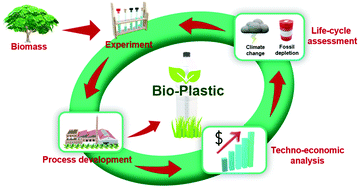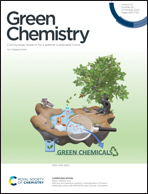Production of a sustainable and renewable biomass-derived monomer: conceptual process design and techno-economic analysis†
Abstract
2,5-Furandicarboxylic acid (FDCA) is a promising renewable building block, which can replace conventional petroleum-derived terephthalic acid (TPA). Here, we develop and evaluate a new catalytic process for the production of a renewable plastic monomer (FDCA) from lignocellulosic biomass-derived cellulose. In this process, cellulose is converted into FDCA (38.6% carbon yield) via a two-step catalytic conversion: dehydration of cellulose to 5-hydroxymethylfurfural (HMF, 42% molar yield) and oxidation of HMF to FDCA (93.6% molar yield). To effectively recover the products as well as recycle the solvent, we designed a detailed separation subsystem, which is integrated with the reaction subsystem. Importantly, to effectively minimize the required energy consumption, a heat pump is employed and heat integration is conducted. In addition, pioneer plant analysis is conducted to investigate the broad range of economic feasibility. In our techno-economic analysis, the integrated process leads to a minimum selling price of $1532 per ton of FDCA, meaning that the cellulose-derived FDCA has the potential to replace petroleum-derived TPA. In addition, sensitivity analysis reveals that the feedstock price and catalyst price are important parameters for the process. Furthermore, according to life-cycle assessment, the biomass-derived FDCA production is more environmentally favorable than the petroleum-derived TPA production.



 Please wait while we load your content...
Please wait while we load your content...